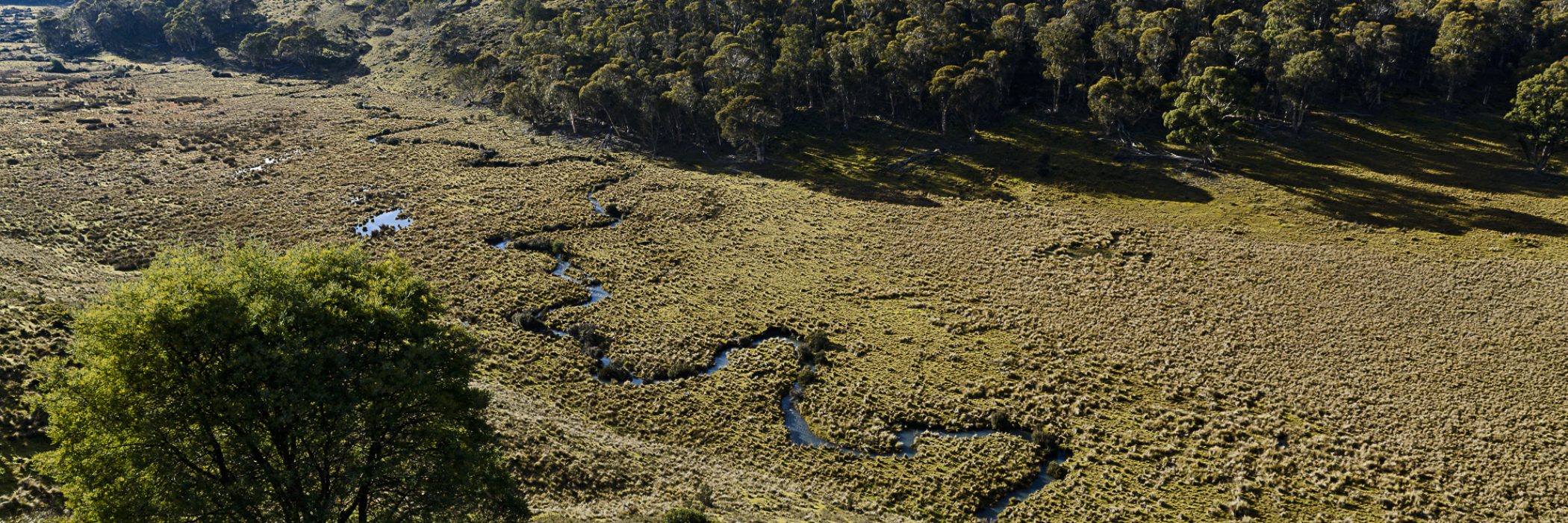Fire recovery at Five Rivers Reserve
Over the last year the TLC and a team of volunteers have been busy working across the Great Pine Tier fire scar on Five Rivers Reserve – thanks to support from a WIRES Landcare Wildlife Relief and Recovery Grant. Thousands of hectares have been scoured up-hill and down-dale for weeds to control, regenerating threatened eucalypts to protect and wildlife activity assessed with strategically placed cameras!

Cider Gum Caging
The iconic Miena cider gum (Eucalyptus gunnii divaricata) epitomises a true Tasmanian – not only is it cold adapted, but it prefers those conditions, seeking out the coldest of waterlogged marshes on the Central Highlands. However, it is also sensitive to change – in climate, fire regimes, herbivory levels, and with the reduction of habitat. The subsequent reduction in the species’ condition and range resulted in its listing as endangered under federal environment legislation.
While the 2019 Great Pine Tier fire varied in intensity across 5,000 hectares of the 11,000 ha Five Rivers Reserve, the highest fire intensity coincided with one of our largest populations of cider gum at Top Marsh. Our surveys over the past two years have found that the mature cider gums did not generally survive those hot fires, standing like sentinels in the landscape. Encouraging, basal resprouting occurred (and persisted) around many of the younger trees and at Top Marsh seedlings were growing around parent trees. However, the very thing (high sugar content sap) that helps cider gums survive cold snaps, becomes the factor that attracts preferential grazing, limiting the potential for new populations to thrive into the future.

To ensure that we maintain these endangered eucalypts into the future post the Great Pine Tier in 2019, the team at TLC has been working to protect populations on our reserve, with the help of some very hardy volunteers!
With the support of WIRES – Landcare Australia we were able to continue this valuable project. In November, TLC staff headed out with a team of six tough volunteers for four days of extreme caging… together we built another 32 cages from weld mesh, designed to meet the test of time. As the team will attest this require an A-Team crew, willing to go the extra mile – carting weld mesh and large rolls of chicken wire through highland marshes and hammering in star-pickets with precision into rocky ground was not for the faint-hearted!
Initially the cages have been capped with wire to protect the cider gums from possums (who are very partial to cider gum on the menu…). However, in a year we will be back to transform those tops into floppy tops, thereby keeping possums out but allowing cider gums to grow tall – eventually replacing the iconic adults killed by fire. The 32 new cages join the previously established cages, protecting cider gums at two sub-populations and spreading the risk between the two sites.

Central Highlands Weeding – Five Rivers
Groups of tenacious volunteers and staff headed out across our Five Rivers Reserve, with weed search patterns in their mind. Five Rivers is over 11,000 hectares and we asked our teams to be as thorough as possible, so over two weeks the teams covered a huge area! They focused their effort into the ~5,000 ha burn scar where the most of our weed threat occurs (78% of weeds controlled and/or recorded for future works).
This year there was a big increase in the number of weeds recorded at Five Rivers. This is likely due to changing our recording system and a warm wet summer two years post-fire. The disturbance responsive weeds (ragwort and mulleins) were the most commonly controlled weeds, and the thistles for follow-up control (with different methods). For example, over 22,000 ragwort were treated, 80% of those in the fire scar (see graph).
The teams’ track logs showed us just how thorough we were, walking large distances off the extensive track network. This resulted in weary muscles, but satisfied teams knowing we covered all the key sites. Together volunteers contributed over 300 hours of weed control effort across just Five Rivers, substantially reducing the weed threat across the reserve post-fire.



Wildlife monitoring
TLC has been undertaking camera monitoring across the Five Rivers Reserve since 2014, surveying mammals across 50 sites. This historical data has provided the valuable ability to understand occupancy trends of mammals pre and post the 2019 Great Pine Tier Fire. Support from WIRES – Landcare Australia allowed TLC to purchase new cameras to increase our survey effort and consequently our understanding across the reserve.
Encouragingly the wildlife cameras tell us that the naïve occupancy (proportion of cameras which record each species) of most of our detectable native species remained stable post-fire (inc. brush-tailed possums, common wombats, Bennett’s wallabies, southern brown bandicoots, spotted-tailed quolls, Tasmanian bettongs, Tasmanian devils, and pademelons). It is particularly great to see this for our threatened Tasmanian devils, which are returning to the expected occupancy following localised disease reprieve. This also appears to be the case with eastern quolls and while echidnas reduced post-fire (which may have been survey timing), neither of these trends are significant. The long-nosed potoroo, notoriously difficult to catch on camera, was not seen this year. We’re looking forward to do follow-up monitoring next year to strengthen our understanding and assess any reduction in occupancy.


We were particularly interested to understand the response of the feral fallow deer and cat populations post-fire. Naïve occupancy and activity (number of detections per trap night) show an increase in deer numbers across the reserve, which is consistent with recent research across Tasmania. Worryingly for the first-time deer were photographed on Skullbone Plains, suggesting that their numbers have increased enough in the World Heritage area to be detected by more than just scats and tracks. Counter to our expectation, there was no significant increase in feral cat naïve occupancy and activity post-fire, staying relatively stable over time, with a surprising up-tick in the year (2018) pre-fire. Our science team are in the process of further analysing and publishing this information. However, information on both deer and cats can already be used to inform future management activities.








